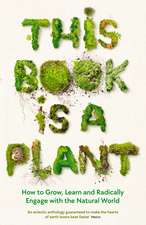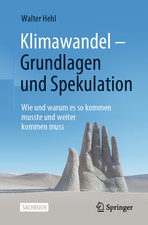Forest Fires: Behavior and Ecological Effects
Editat de Edward A. Johnson Kiyoko Miyanishien Limba Engleză Hardback – mar 2001
Preț: 538.41 lei
Preț vechi: 727.47 lei
-26% Nou
Puncte Express: 808
Preț estimativ în valută:
103.04€ • 107.18$ • 85.06£
103.04€ • 107.18$ • 85.06£
Carte tipărită la comandă
Livrare economică 07-21 aprilie
Preluare comenzi: 021 569.72.76
Specificații
ISBN-13: 9780123866608
ISBN-10: 012386660X
Pagini: 594
Dimensiuni: 152 x 229 x 43 mm
Greutate: 1.04 kg
Editura: ELSEVIER SCIENCE
ISBN-10: 012386660X
Pagini: 594
Dimensiuni: 152 x 229 x 43 mm
Greutate: 1.04 kg
Editura: ELSEVIER SCIENCE
Public țintă
Professional entomologists, horticulturists, farm managers, crop consultants, and scientists in related fields of agriculture. Lecturers, graduate students, and researchers in the plant sciences.Cuprins
Contributors
Preface
Acknowledgments
1 Strengthening Fire Ecology's Roots
I. Introduction
II. Processes
III. Transfer Rates and Budgets
IV. Examples of Traditional vs. Proposed Approach
References
2 Flames
I. Introduction
II. Basic Aspects of Combustion in Forest Fires
III. Temperature, Velocity, Species Concentration, and Flame Height
IV Premixed and Diffusion Flames
V. Extinction of Diffusion Flames
VI. Diffusion Flames and Scaling Analysis
VII. Spreading Flames
VIII. Structure of Flame Base
IX. Conclusions
Notation
References
3 Combustion Chemistry and Smoke
I. Introduction
II. Fuel Chemistry and Combustion
III. Smoke Production
IV. Minimizing Smoke Production
V. Conclusions
References
4 Water Relations of Forest Fuels
I. Introduction
II. Forest Fuels
III. Fuel Moisture Relationships
IV. Moisture Content Estimation
Notation
Additional Reading
References
5 Wildland Fire Spread Models
I. Introduction
II. Head Fire Rate of Spread (Physical Principles and their Mathematical Embodiment)
III. Head Fire Rate of Spread: Australia
IV. Head Fire Rate of Spread: United States
V. Head Fire Rate of Spread: Canada
VI. Smoldering
VII. Whole Fire Modeling—Fire Shape
Notation
References
6 Wind-Aided Fire Spread
I. Introduction
II. Laboratory-Scale Setup
III. Fire Spread Model
IV. Preliminary Testing of the Model
V. Test Results for the Effect of Wind Speed and Fuel Loading on the Rate of Fire Spread
VI. Conclusions
Notation
Recommended Reading
References
7 Fire Plumes
I. Introduction
II. Modeling Fire Temperature Maxima
III. Plumes above Fires in a Cross Wind
Notation
References
8 Coupling Atmospheric and Fire Models
I. Introduction
II. Vorticity Dynamics in a Fire
III. Coupling between Atmosphere and Fire
IV. The Elements of Fire Modeling
V. Modeling the Atmosphere
VI. The Coupled Fire—Atmosphere Modeling Approach
VII. Idealized Studies of Wildfire Behavior
VIII. Infrared Observations of Fires
IX. Conclusions and Future Work
Appendix I. Circulation and Vorticity
Appendix II. Development of Vertical Rotation in a Frictionless Fluid
Appendix III. Generation of Vertical Motion in Rotating Convective Cells
Notation
References
9 Surface Energy Budget and Fuel Moisture
I. Introduction
II. Evapotranspiration Processes and the Meteorological Controlling Factors
III. Estimation of Potential Evapotranspiration Rates
IV. Functional Dependence of PET and AET
V. Characteristics of PET
VI. Near-Surface Environment
VII. Models of Land-Surface Interactions
VIII. Remote Sensing of the Surface Energy Budget
IX. Fire Weather Rating Systems
Notation
Suggested Reading List
References
10 Climate, Weather, and Area Burned
I. Introduction
II. Weather and Area Burned—Synoptic Surface Features
III. Weather and Area Burned—Upper Air Features
IV. Teleconnections
V. Future Warming and Area Burned
VI. Summary
References
11 Lightning and Forest Fires
I. Introduction
II. Lightning
III. Previous Studies of Lightning-Initiated Fire
IV. Interaction between Lightning and Fuels
V. How Ignition Occurs
VI. Ignition Experiments with Real Forest Fuels
VII. Generating Models for Operational Use
VIII. Smoke, Lightning, and Cloud Microphysics
IX. Global Implications of Lightning Ignition Characteristics
X. Conclusion
References
12 Statistical Inference for Historical Fire Frequency Using the Spatial Mosaic
I. Introduction
II. Graphical Analysis
III. Statistical Inference with Prespecified Change Points
IV. The Efficiency of Sample vs. Map Data
V. Determining Epochs of Constant Fire Frequency
References
13 Duff Consumption
I. Introduction
II. Characteristics of Duff
III. Empirical Studies of Duff Consumption
IV. Flaming Combustion
V. Smoldering Combustion and Pyrolysis
VI. Models of Smoldering Combustion
VII. Contribution of Smoldering Combustion Models to Understanding of Duff Consumption
Notation
References
14 Fire Effects on Trees
I. Introduction
II. Effects of Fire on the Tree Bole
III. Effects of Fire on Canopy Components
IV. Root Necrosis
V. Tree Mortality
VI. Discussion
Notation
Additional Readings
References
15 Forest Fire Management
I. Introduction
II. The Relationship between Fire and Forest Land Management Objectives
III. Assessing Fire Impacts
IV. Forest Fire Management Organizations
V. Level of Fire Protection Planning
VI. Some Challenges
Further Reading
References
Index
Recenzii
"...a rich summary of our current knowledge of several important aspects of forest fire science, from fuel dynamics to coupled atmosphere-fire modelling. ...The book's strength is as a state-of-the-art review of research on pyrolysis, flames, lightening, fuel-moisture dynamics, smoke, combustion chemistry, and more. ...My fire science students and colleagues use Forest Fires as a reference." --Daniel Nepstad, Woods Hole Research Center, in NATURE (January 2002)
"...a primary strength of this book is that you can find a larger number of state-of-the-art fire behavior and combustion topics covered in a single source. ...the book is an unmitigated success...a very strong book that will benefit most scientists interested in fire, including ecologists. ...Overall, I compliment the editors and authors for a job well done." --Marc D. Abrams, Pennsylvania State University, School of Forest Resources, in ECOLOGY (November 2001)
"This book is authoritative, well written and abundantly referenced. ...a valuable resource on all the topics covered and is likely to remain so for many years. ...It is a book that researchers in fire ecology should be aware of and have access to." --John Ogden in ANNALS OF BOTANY (2001)
"...a primary strength of this book is that you can find a larger number of state-of-the-art fire behavior and combustion topics covered in a single source. ...the book is an unmitigated success...a very strong book that will benefit most scientists interested in fire, including ecologists. ...Overall, I compliment the editors and authors for a job well done." --Marc D. Abrams, Pennsylvania State University, School of Forest Resources, in ECOLOGY (November 2001)
"This book is authoritative, well written and abundantly referenced. ...a valuable resource on all the topics covered and is likely to remain so for many years. ...It is a book that researchers in fire ecology should be aware of and have access to." --John Ogden in ANNALS OF BOTANY (2001)




















